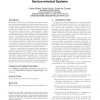75 search results - page 14 / 15 » The Continuance of Online Social Networks: How to Keep Peopl... |
CORR
2010
Springer
13 years 5 months ago
2010
Springer
Abstract--Breadth First Search (BFS) and other graph traversal techniques are widely used for measuring large unknown graphs, such as online social networks. It has been empiricall...
HICSS
2008
IEEE
14 years 7 days ago
2008
IEEE
Persistent digital media extend content beyond immediate ephemeral interactions and conversations. Systems such as email, instant messaging, digital kiosks, social networking site...
CSCW
2008
ACM
13 years 7 months ago
2008
ACM
Tightly-coupled interaction is shared work in which each person's actions immediately and continuously influence the actions of others. Tightly-coupled collaboration is a hal...
GROUP
2009
ACM
14 years 8 days ago
2009
ACM
Recent technologies supporting continuous connectivity enable sustained awareness within social networks, which eventually boosts interaction and therefore the need of individuals...
SAC
2010
ACM
14 years 18 days ago
2010
ACM
Web-based collaboration systems typically require dynamic and context-based interactions between people and services. To support such complex interaction scenarios, we introduce a...




